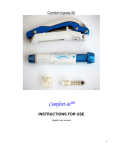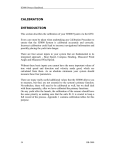Download Service Manual LEVO AG
Transcript
Manual to Frequently Asked Questions 1 Index 1. Introduction _________________________________________________________ 2 2. Benefits of standing in a wheelchair _______________________________ 3 2.1. Medical/therapeutic benefits _______________________________________ 3 2.2. Functional benefits __________________________________________________ 4 2.3. Psychological benefits_______________________________________________ 4 2.4. Economical benefits _________________________________________________ 4 3. Correct Standing _____________________________________________________ 5 3.1. How do I stand correctly in the LEVO wheelchair _________________ 5 3.2. Incorrect standing - usual causes and how to correct it __________ 6 4. How often and how long should I be standing in the wheelchair? 7 5. Periodic checks of the LEVO wheelchair and your sitting practice.8 6. LEVO is at your disposal – worldwide! _____________________________ 8 1. Introduction For over 30 years LEVO has been specialized in stand-up wheelchairs and covers the complete range of manual to power wheelchairs (with rear and center wheel drive) for children and adults. LEVO wheelchairs are ergonomic adjustable to the various body mass proportions and thereby allow comfortable sitting and standing in the wheelchair. LEVO has close connections with university hospitals and incorporate their studies constantly into further development. LEVO is represented in more than 30 countries worldwide and one of their most concerns is the current technical training of their representatives to ensure the best possible benefits for the wheelchair user. A stand-up wheelchair has specialty functions in addition to serving as a traditional wheeled mobility device. The seating and standing positions are equally important and are interacting features. If the stand-up wheelchair has been adapted correctly to your personal requirements, you should feel comfortable when sitting, standing and in all positions in between. You should: Feel relaxed and secure when sitting or standing, without feeling unstable. Not feel constricted in your activities by too many supports. Sit and stand as upright as possible without feeling unstable. Sit as symmetrically as possible, i.e. with your trunk and hips in midline. Refer to our Service Manuals for further information. 2 2. Benefits of standing in a wheelchair 2.1. Medical/therapeutic benefits Circulation: Standing helps the circulation. Regular changes of position may assist in decreasing edema (swelling in the legs), dizziness, nausea and fatigue. Spasms: User feedback suggests that a daily standing training program of a minimum of 30 minutes reduces spasms. Pressure Ulcer: Asymmetrical pressure and/or excessive pressure can reduce the blood circulation to sensitive parts of the skin (over bony areas). In the standing position, these areas are relieved of pressure and the circulation increases. -5° seating +15° working +45° standing +80° Contractures: Many wheelchair users develop contractures and exhibit decreased range of motion of the joints. Daily standing exercises can reduce or prevent such contractures. Surgical treatment of contractures is expensive and time consuming as well as painful for the person concerned. Contracture prophylaxis is of vital importance, especially for growing children. Bladder function: Due to higher blood calcium (see Osteoporosis/Bones) more calcium is being washed out by the kidneys and thereby causes an increased risk of renal calculi, bladder stones and corresponding infections. By standing the muscle tonus of the bladder may be increased, the blood calcium concentration reduced and an optimal position for bladder emptying is achieved. Improved digestion: Daily standing exercises can help to shorten the ½ - 2 hour time commitment normally required to complete a bowel program for people with SCI Healthy bone Osteoporotic bone Osteoporosis: The loss of bone mineral is mainly caused by lack of weight bearing through the bones. Weight bearing can play an important role in preventing or retarding bone mineral loss after SCI. For healthy bone growth, children should start daily standing exercises at the age of 9-14 months. Standing program should include at least 2 sets of 30 minutes with 80% of their body weight. 3 2.2. Functional benefits Besides the medical benefits, the functional factors are equally important. Thanks to the standup wheelchair, people are able to stand up wherever they want and perform functional activities, such as reaching for objects in cupboards, without help of another person. Independence can be achieved at home, at school, at the workplace and at leisure. 2.3. Psychological benefits Studies indicate that 69% of wheelchair users felt their life quality improved because of the ability to stand. Standing in the wheelchair improves quality of life through increased independence and better integration. For example, they are able to participate in more conversations eye to eye, and an increased self-esteem. Increased possibilities for leisure activities become available. Increased independence leads to a decreased reliance on others. 2.4. Economical benefits The environment does not have to be altered to the same extent as for someone who uses a standard wheelchair, which enables an easier rehabilitation and integration at the home and workplace. Wheelchair users can use normal, not specially modified kitchens, at home or on holiday. Lower medical costs are beneficial both to the healthcare system and the individual. 4 3. Correct Standing 3.1. How do I stand correctly in the LEVO wheelchair The LEVO wheelchair must be adjusted to accommodate your height, and to meet your biomechanical requirements. Each model is available in a variety of sizes. The size should be selected to most closely match your height and body dimensions. The components can then be further fine tuned to meet your needs 3.1.1. Correct seat depth: A B C 85° A. Knee support attachment screw shall be even with the centre of the knee joint! B. In fully upright position the ankle, the knee joint, the hip joint and the shoulder joint shall be straight in line! C. The full upright position can be in 75-85° angle to the floor. This depends on the stability of the trunk and the user’s comfort. 3.1.2. Correct adjustment of knee support, chest strap and footrest: E D The knee support should be 2-3 cm below the kneecap (see “D”) and be secured so that a hand could easily slide between the leg and knee support in the seated position (see “E”). Correctly adjusted, the pressure of the knee support on the shinbone will never be more than 20% of the body weight The height of the chest strap depends on the degree of trunk control. It can be fixed at different heights on the backrest upholstery. Secure the chest strap so that when sitting a fist easily slides between strap and the trun Set the footrest height so that your thighs are resting evenly on the seat! Right! Wrong! 5 3.2. Incorrect standing - usual causes and how to correct it The seat is too deep or too short: When set correctly, the length of thigh (measured from the rearmost point of the bottom to the hollow of the knee) should correspond to the seat depth and the knee support attachment screw should be in line with the centre of the knee. 3.2.1. Seat depth too long: G F Knee support attachment screw is beyond centre of knee (see “F”). While moving into standing, you may slip down wards which results with shearing forces. Also in full standing up position the knee joint is hyper extended (see “G”). 3.2.2. Seat depth too short: H I Knee support attachment screw is behind centre of knee (see “H”). While moving into standing, you may be pushed up which results in high pressure on the knee support as well as shearing forces. Also in full standing up position the knees are not fully straight extended (see “I”). 3.2.3. Seat cushion is too high/thick: J K A high profile seat cushion shall not be brought on the top of the seat support (see “J”). It must be dropped. In seating position it may work but once you get in a standing it causes hyper- lordosis as well as high pressure on the thigh and hyper extended knee joints (see “K”). 3.2.4. Backrest is too far forward or is too tense/taut: L M A solid backrest or support cushion which is used for more comfort and stability shall be in line between the backrest tubes. Wrong adjustments or a too thick cushion in front of backrest upholstery (see “L”) may cause a hyper extended spine, a tilt pelvic or an incomplete hip extension (see “M”). Pelvis tilts forward when standing which could cause low back pain (see “N”). Use pelvic belt to tilt pelvis back toward neutral position when standing (see “O”). N O 6 Thighs should be in as neutral alignment as possible. Before trying to make corrections, first make sure that the user has adequate hip joint range of motion P Q R 3.2.5. If the legs are turning inwards, a medial knee support pad may improve alignment (see “P”). 3.2.6. If one or both legs are falling outward, a lateral thigh or knee support pad may improve alignment (see “Q”). 3.2.7. If both legs are tipping to one side, use of both a medial and a lateral knee support pad may improve alignment (see “O”). Caution: make sure that aligning the thighs forward does not cause the trunk to rotate. Take care, that this solution does not cause problems elsewhere in the body, like spasms, dislocation of the hip. Creating a stable seating as basic is the most important thing, which often may be reached by using a firm seat plate instead of the seating upholstery. 4. How often and how long should I be standing in the wheelchair? Frequent, short standing periods are more effective for health than infrequent, longer standing periods. If you wish to keep track of your standing, we offer an optional monitor, which can be motivating similar to monitoring devices on fitness equipment. Vary your seating position in the LEVO as often as possible! A common position of stability for an active wheelchair user has a posterior tilted seat angle of about five degrees! B. Engström Some people benefit from a forward tilted seat for a functional working position, which promotes a better pelvis-spinal alignment. The LEVO offers variations of this position for all chairs! B. Engström S A regular and independent standing exercise without any transfer is possible with any LEVO chair – wherever you stay! *Pressure recording in April 2004 taken from a person with quadriplegic at the Swiss Spinal Cord Hospital in Nottwil by using the “Xsensor” pressure measuring instrument. An open sitting angle affects a tilt pelvis and a stretched spine, a position recommended especially when sitting in front of a computer, at dinner tables etc. which shows positive effects on your back position (see “S”). 7 You should be standing every day for a minimum of 30 – 45 minutes. We recommend integrating the standing training in your daily activities, e.g. in leisure time, when watching television, at your workplace etc. You can stand anywhere, as with a LEVO you are not bound to a certain location. In addition the maxim is: Better to stand every day for too short a period than not at all! Be aware, that the pedestrian also has to do something for his health every day! 5. Periodic checks of the LEVO wheelchair and your sitting practice. We recommend that, after approx. 3 months time after the purchase of the wheelchair, you contact your supplier and/or the evaluating therapist to check that you are still sitting and standing correctly in your wheelchair. At this occasion slight adjustments can be made and other modifications can be considered based on your experiences with the chair. It is our goal that you always feel comfortable in your LEVO, which should always be the case, when the chair has been correctly adjusted. Should you at any time not feel positioned well in your chair, please contact your equipment supplier. This is the only way the chair can always fit your needs. Generally each wheelchair user should have the chair examined 1x year by his supplier. The following should be inspected: Are you still sitting and standing correctly? Problems like asymmetric pressure on the bottom cause pressure ulcers as well as significant secondary medical costs. For each model there is a service sheet based on which the service should be carried out. A copy has been supplied with your warranty card. Please hand it over to your supplier who in turn will carry out the service according to this sheet. 6. LEVO is at your disposal – worldwide! Each LEVO wheelchair carries a serial number, which allows LEVO to check at any time which parts have been mounted on this chair and which technician assembled the chair or performed the final inspection. Should a part become defective, please give your supplier your chair’s serial number in order that the correct part can be ordered. LEVO guarantees delivery of spare parts for a minimum of 5 years after production of that model has been stopped. In our Swiss plant, we even stock some older parts. LEVO is represented in more than 30 countries. On our website (www.levo.ch) you can find a local LEVO dealer. If you cannot find a dealer near you, take a digital photo of the part – or describe it (if you are not in possession of a service manual where all parts are listed by numbers) and contact us directly in Switzerland. We shall do our utmost to supply the desired part per fast delivery and a description of how it has to be mounted. If you are working with a supplier, this technical description will be forwarded directly to the supplier who is undertaking the repair. By regular product training LEVO ensures that their partners are always on the latest status of technical and medical knowledge. LEVO supports medical examinations and studies worldwide to achieve an increased awareness of the benefits of standing. Our goal is not only to produce quality and aesthetically pleasing wheelchairs and to service them worldwide, but also to serve the user with their product needed. We welcome any feedback. This way we are able to constantly optimize our chairs in order to serve our current and future customers with the best wheelchair possible. Many thanks! 8














